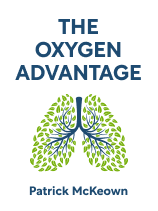

This article is an excerpt from the Shortform book guide to "The Oxygen Advantage" by Patrick McKeown. Shortform has the world's best summaries and analyses of books you should be reading.
Like this article? Sign up for a free trial here.
Why should you train yourself to take fewer breaths? How can you breathe less?
Because modern society predisposes you to breathe too much, correcting this unhealthy habit requires you to deliberately train yourself to breathe less. The primary goal of this training is to build up your body’s tolerance to carbon dioxide, according to Patrick McKeown’s book The Oxygen Advantage.
Continue reading to learn how to breathe less and improve your health.
Train Yourself to Breathe Less
As you learn how to breathe less, your body learns to live and move with greater levels of carbon dioxide in your blood without urging you to breathe more. This allows more oxygen to get to your muscles and organs both at rest and during exercise, greatly improving your physical fitness and overall health.
(Shortform note: Although the idea of carbon dioxide tolerance has only recently become popular, James Nestor describes in Breath how medical professionals well over a century ago were unknowingly helping patients increase their carbon dioxide tolerance. As early as the 1870s, British doctors were telling their patients to soak in carbon dioxide-rich mineral springs, which yielded long-term health benefits after just a few sessions. Since then, medical professionals using CO2 to treat ailments as wide-ranging as pneumonia, epilepsy, and schizophrenia reported similar all-around health benefits to those McKeown promises—until the practice fell out of fashion around the time that pharmacology became widespread.)
Next, we’ll detail the steps for training yourself to breathe less, beginning with the one habit that makes the biggest difference to your respiratory health and advancing to other exercises that improve your breathing.
The Golden Rule: Breathe Through Your Nose
McKeown’s main recommendation that anyone can use to improve their breathing is to exclusively breathe through the nose, not the mouth—even when exercising.
The primary reason nasal breathing is so healthy is that it naturally limits the air you can breathe—nasal passages are much narrower than your mouth. Thus, breathing through your nose reduces the symptoms of heavy breathing we discussed previously.
Breathing solely through your nose provides many other health benefits:
Benefit #1: Naturally Diaphragmatic Breathing
The diaphragm is the muscle at the bottom of your chest cavity that moves while you breathe. According to McKeown, people who breathe through their nose benefit from naturally diaphragmatic breathing—while breathing, they fully flex the diaphragm. Diaphragmatic breathing is what experts mean by healthy “deep” breathing—your breath reaches deep into your lungs.
Diaphragmatic breathing is beneficial because it activates the parasympathetic nervous system—the network of nerves that causes you to relax in safe environments—taking you out of fight-or-flight mode, which helps you avoid instinctively breathing too much. By contrast, mouth breathers often breathe using just their upper chest, with minimal movement of the diaphragm—therefore, they don’t experience these benefits.
Benefit #2: Better Respiratory Hygiene
Nasal breathing is essential to proper hygiene within your respiratory system, asserts McKeown. Air you inhale through the nose is healthier than air you inhale through the mouth. Inside the nose, there’s a complex system of twisting bones, passageways, and layers of mucus. This system strips harmful germs out of the air, warms the air up, and adds moisture to it before allowing the air to pass into the lungs.
Mouth breathing, on the other hand, causes you to lose moisture every time you take a breath, increasing the likelihood of general dehydration and a dry mouth. In particular, having a dry mouth increases the likelihood of mouth infections, including cavities and gum disease, and it often results in bad breath.
Benefit #3: Increased Nitric Oxide
McKeown asserts that nasal breathing makes you healthier by increasing the nitric oxide in your body. Your nose naturally produces this gas, and you get more of it in your body every time you breathe in through your nose. Nitric oxide helps your blood vessels remain relaxed and open, increasing blood flow and improving cardiovascular health. It also lowers your blood pressure and cholesterol, and it reduces the risk of heart attack or stroke.
Benefit #4: Improved Sleep
Nasal breathing helps improve your sleep quality, according to McKeown—it helps you fall asleep faster, stay asleep more easily, and wake up with more energy to start your day. Additionally, it decreases the likelihood that you’ll suffer from snoring or sleep apnea.
If you wake up with a dry mouth in the morning, it’s a sign that you’re breathing through your mouth while asleep. In this case, put paper tape or commercially available sleep tape over your mouth just before you go to bed until you’ve built the habit of sleeping with your mouth closed.
How to Breathe Less: Specific Exercises
Next, we’ll describe several exercises that McKeown offers to improve your respiratory health.
Exercise #1: Testing Your Carbon Dioxide Tolerance
McKeown recommends regularly testing your carbon dioxide tolerance to track how healthy your breathing habits currently are. The breathing exercises that McKeown recommends vary depending on your current CO2 tolerance, so testing it helps you know which exercises to include in your routine. Tackling intense breathing exercises before your body is ready will tire you out quickly with minimal benefits, and trying and failing at these exercises will only discourage you from sticking with the program.
To test your carbon dioxide tolerance, take a normal breath; then, at the end of your exhale, plug your nose and hold your breath. Time how long it takes before you first feel the need to breathe (not how long you can hold out before you have to breathe).
This time represents how tolerant your body is to carbon dioxide, and it’ll increase as your tolerance increases. A typical adult who exercises frequently can go 20 seconds before feeling the need to breathe, but McKeown recommends training your body until you can make it to 40 seconds to achieve peak physical fitness.
For the most accurate assessment, perform this exercise immediately after waking up. Your unconscious breathing while asleep will be the same every night, putting your respiratory system in a neutral state and ensuring that your test will be consistent and objective.
Exercise #2: Unblocking the Nose
As we’ve established, the first step in improving your breathing habits is breathing through your nose at all times. McKeown notes that unfortunately, nasal congestion is a major obstacle for many habitual mouth breathers who want to make this change. Mouth breathing can cause your nasal capillaries to become inflamed and your nose to produce more mucus, which contributes to nasal congestion.
(Shortform note: The condition of inflamed nasal capillaries resulting in increased mucus production is called vasomotor rhinitis. However, if your nasal congestion is accompanied by an itchy nose, itchy or watery eyes, and a sore or irritated throat, it’s likely that you’re simply suffering from allergies rather than excessive breathing—this is called allergic rhinitis.)
Luckily, McKeown prescribes a specific exercise to break out of this cycle and start breathing through your nose. Exhale, then plug your nose, hold your breath, and walk around until you feel a strong need to breathe. Let go of your nose and take a calm, slow nasal breath in. Recover for a short time, then repeat until your nose is less congested. Eventually, repeating this exercise will allow you to hold your breath for longer, and as your body adapts, your nose will become permanently clearer.
Exercise #3: Breath Reset
This next exercise resets your breath from heavy breathing back to a calm state. McKeown recommends using it as a post-workout cooldown.
To practice this exercise, walk around, breathing smoothly and slowly. Exhale, then hold your breath for two to five seconds. Release and breathe normally for 10 seconds, and repeat until you’ve reset to your normal at-rest breathing pattern.
Exercise #4: Basic Carbon Dioxide Training
The core exercise you’ll use to increase your carbon dioxide tolerance is a breathing procedure you can do while sitting or lying down (McKeown calls this the “Breathe Light to Breathe Right” exercise). If your carbon dioxide tolerance time is 15 seconds or more, you’ll typically be able to complete and benefit from this exercise. McKeown recommends practicing this for 10 minutes, three times a day.
Place one hand on your chest and one hand on your belly. Breathe slowly and deliberately with your diaphragm—the hand on your belly should move while the hand on your chest remains relatively still. Press into your body with your hands, physically pushing against the breath as you inhale. The goal here is to reduce the amount of air you breathe in—with every breath, inhale less air until you’re breathing far less air than you typically do. If you feel like you’re breathing less than your body wants you to, you’re successfully training your carbon dioxide tolerance.
When performing this exercise, relax your body—none of your muscles should feel tense. If you ever feel yourself involuntarily tense up or your breathing becomes jerky and unstable, take a break—the goal is smooth, easy breathing that slightly challenges your desire to breathe. If you struggle to achieve this, you may need to build some carbon dioxide tolerance before adding this exercise to your routine. You can use nasal breathing and the breath reset exercise described above to do so.
Exercise #5: Carbon Dioxide Training in Motion
Once you’ve practiced the basic carbon dioxide training at rest and your carbon dioxide tolerance has measurably increased, McKeown recommends working your way up to executing the training during physical exercise—while walking, running, or cycling. This intense practice will further increase your tolerance to carbon dioxide. There’s no need to use your hands when doing this, but continue to keep your body relaxed and stretch your ability to breathe less than you feel like you need to.
Note that McKeown doesn’t recommend advancing to any breath exercise more intense than the basic carbon dioxide training if you suffer from a medical condition that could be exacerbated by physical exertion. In this case, consult your physician before undertaking these more advanced breathing exercises. Similarly, if you start to feel dizzy or sick, stop the exercise immediately.

———End of Preview———
Like what you just read? Read the rest of the world's best book summary and analysis of Patrick McKeown's "The Oxygen Advantage" at Shortform.
Here's what you'll find in our full The Oxygen Advantage summary:
- How proper breathing can help you lose weight, sleep better, and more
- How modern living conditions cause people to breathe too much
- Training exercises to help you breathe less and build CO2 tolerance






